Manifest Gallery is not shy about being ambitious in its prompts for exhibitions, and few shows that I have seen there are more ambitious than “MARK: About the Artist’s Hand.” The mark is very close to the molecule of art. Many of the questions and ideas raised by this show could readily be applied to any or all of the Manifest’s other three exhibits running concurrently: this show, with its 21 works by 17 artists, is a well-selected take on some pretty central issues. The wall tag tries to set out the exhibition’s governing principles: “Art builds from a touch.” This tells us from the start that “MARK” is going to be a show that asks us to call to mind the physicality of art-making; we ought to be seeing traces of the artists’ connections to their bodies, though I’m not sure how much we do, in the end. There are links between mark-making and style; an essential part of traditional connoisseurship is the minute examination of the artist’s marks. But aside from finger-painting—which may be the beginning place for our own acquaintance with mark-making in childhood—the artist’s marks are usually left behind by intermediaries–tools and instruments of various sorts. The wall tag continues: “MARK is an exhibit about the artist’s hand, the signature left by the maker’s tool, and the energy it contains.” Though mark-making is far from a deliberate or wholly rational process, it remains to be seen whether it could truly be done by a machine, though in its own way, a brush is a machine almost as much as a computer program is.
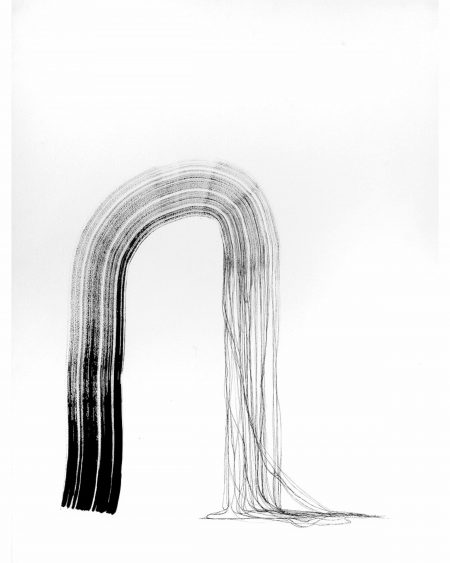
It would be impossible for any one show to truly investigate the mark, let alone one at the Manifest, where most everything must be miniaturized to fit the small sizes of the gallery’s spaces. But while “MARK” cannot possibly be a comprehensive look at its subject, nor does it really explore the frontiers of the concept in contemporary art, many of the works are particularly thoughtful about what an artist’s mark is, does, and claims. Sabrina Sabella’s “Blends” (2019), for example, is a highly effective investigation of how marks work. Reading it from left to right, a broad brush stroke ascends, takes a steep curve downward, and breaks up into a tangle of stringy lines. (It would be interesting to imagine how the piece might read if we saw it from right to left.) In the course of the piece acquiring shape, the nature of the artist’s marks changes. As a brush stroke, it is flat—it has no relationship to gravity or, really, to anything else but the ink of which it is made and the paper on which it sits. As it descends and is transformed into lines, it acquires weight and dimension; the lines seem to gather into a pile on what has suddenly become a horizon line. The piece depicts two types of patterns that work in two different ways, but can be seen to morph, one into the other.
A number of the works in the show seem particularly well-chosen for their exploration of how different types of marks work together (or oppose each other). Travis Schmiesing’s “Unknown Model” (2020) is a kind of anthology of some of the many ways charcoal makes marks: he uses the broad side of the charcoal stick to make flat shapes of medium density where the paper shows through, presses down hard to make the blacks the constitute the figure’s center, rubs and scuffs the charcoals to get what passes for flesh tones and an enigmatic face, and uses a sharp point to make a number of free lines that seem to fly free from the figure. The face is hard to read: it looks out at us directly, almost confrontationally, but its eyes seem closed. It is not a portrait—hence, perhaps, the work’s title—but almost a stick figure or a doll. It is figurative, but as a character, it seems hypothetical at best. It reminds us that mark-making is particularly closely allied to sketching, where the work of the artist’s hand is meant to be seen (and possibly enjoyed and valued) chiefly by the artist themselves, turning a real-world observation into something two dimensional, permanent, and portable.
I found myself returning to the small collection of exuberant lines that emanate from the figure’s neck and face. They seemed non-referential—they do nothing to anchor the body in space, and possibly do just the opposite, celebrating the drawing as a production whose source is the artist’s hand, rather than a “model” (a term that can become wonderfully interesting and problematic if thought about for a while). There is a wildness to these lines, though it also must be acknowledged that they could have been even more considerably out of control. They chiefly form a sort of halo around the figure’s head. The artist makes marks that are both excitable and also capable of being restrained.
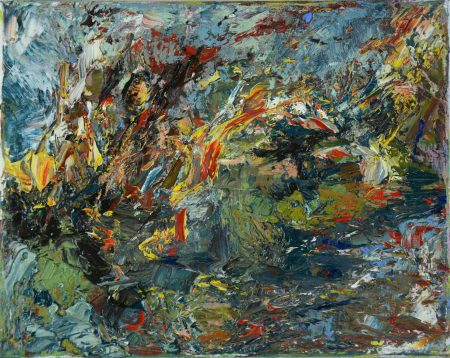
If we think of the ways that an artwork celebrates the artist’s hand, we can go back to Neolithic cave paintings which are signed literally by hand or zoom through the ages to the abstract expressionists, where the hand wielding the brush is virtually all in all. The Manifest show pays attention to the relevance and tools of abstract expressionism with Felicia Leach’s “Fire Break Shore” (2021), a particularly energetic collection of brush marks, tightly contained in a shadow box frame. (There’s no point harping on how the Manifest’s limited physical spaces—and commitment to multiple shows at once, virtually one per room—tend to create the need to deal in miniaturizations of significant ideas. Certainly in a work like Leach’s that seems intended to invoke abstract expressionism, one misses the element of scale.) The work’s title—“Fire Break Shore”–encourages us to reduce the level of abstraction and read the work in terms of a sort of landscape and even narrative: a world is aflame, but the fire is being largely contained by some body of water. There is an interesting tension between the painting’s swirling overall design and the way an imputed shoreline creates visible order in the form of a sort of horizon. The energy of the fire is acknowledged in the way the fire drops burning fragments—or just pure flame—into the water. I don’t want to understate, however, the work’s abstraction: we can identify no tangible objects or forms anywhere. All we have to see are the layered dabs of paint from the artist’s brushes. It is a kind of miracle of the ways that painting communicates to its viewers that we are allowed to attribute the blue at the bottom to water and the blue at the top to sky, though neither is drawn in a referential way.
Tracy Hill’s lithograph “Passing Between” (2021) plays with the artist’s and the medium’s mark-making capacities to create a fantastic world. The overall image is more or less ear-shaped and calls to mind the body, though it could also suggest a huge boulder. The landscape vision it might suggest is emphasized by a kind of fringe at top that might be a glimpse at a distant tree-covered prospect. The lithograph looks like it has been created with liquid tusche which, as it dries, creates networks of fine lines and curves, which in this case add to the impression of landscape by suggesting a contour map. On the right side of the print is a large, wholly black oval; on the left side is a large, wholly white area with no lines or curves at all. The print exists in a sweeping but narrow zone, from the hint of a landscape at the top to the striated lobe at the bottom, between these two areas where there are no marks at all. It serves as reminder that part of the drama of the artist’s marks is when we might expect them but don’t have them. Here, the white area calls to mind the swelling of a steep, sunlit decline while the black area has the frightening emptiness of a confrontation with the sublime, the unseeable, and possibly the dangerous. In both cases, we are reminded of how much we are oriented and anchored—thankfully–by the lines and marks elsewhere.
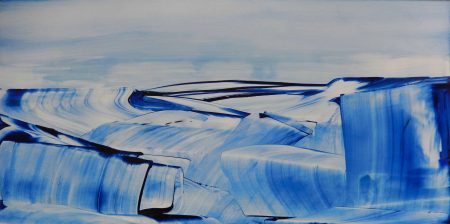
The marks of Pirjo Berg’s “Beyond the Sea” (2021) are for the most part made by pushing paint around with a palette knife or similar implement. The result is a painting that suggests both a heaving, swelling ocean gathered into falling, intersecting waves, and a clutter of dislocated ice if all the ice’s edges were soft—a seascape of a watery but chilly world that could never exist. These waves roll, but also fold. We’d enter this world at our own risk. The sky is suggested by a more conventional style of painting; it is softer, shows brushwork, and is more illusionistic, suggesting a distant storm. Berg’s work is particularly at home in a show like this where the nature of the mark has the power to suggest the nature of a fictive landscape, as it did for Tracy Hill’s litho.
At first look, Gianluca Giarizzo’s “Studia 8-24” (2021) is represented in the show to root the idea of the mark in the traditional realm of the figurative sketch. “Studia 8-24” features the sepia, cross-hatched lines of a chiaroscuro studio drawing. It is impossible not to appreciate the value of well-trained lines arranged to suggest form and weight. The figure is statuesque. But Giarizzo’s main figure is accompanied by a sort of secret self, a ghost all in white that is like a bleached shadow or doppelganger. The work attains a haunting sort of power by pairing a familiar style of marking with an uncanny sort of markless blank. It is as if we are looking at Rodin’s “Balzac” if it were accompanied by a sort of counter-self. Kelly Isaak’s “Things Unsaid” (2021) continues to explore the show’s interest in figurative and portrait work. To the patient, careful graphite sketching of the subject’s face, Isaak adds the impact of liquid graphite to the top knot of the subject’s hair, her collar and her clothes. The goal seems to be to bring together the linear and the liquid, but also perhaps the meticulous with the hasty, the patience of the traditional drawing with the bravura gesture of the dripping brush. It is as if John Singer Sargent were completing a sketch by an accomplished academic portraitist. The brushy waves of hair and clothes—which I assume cannot be revised once placed on the paper—bring with them the familiar paradoxes of modernity: they are energetic, even dashing, on the one hand, but are always going to seem flat, belonging more to the world of the paper than the expression on the model’s face. The physiognomy suggests the ways that an artist produces a finished product; the hair and the clothes suggest the artwork as a process, a thing alive in its own right and always underway.
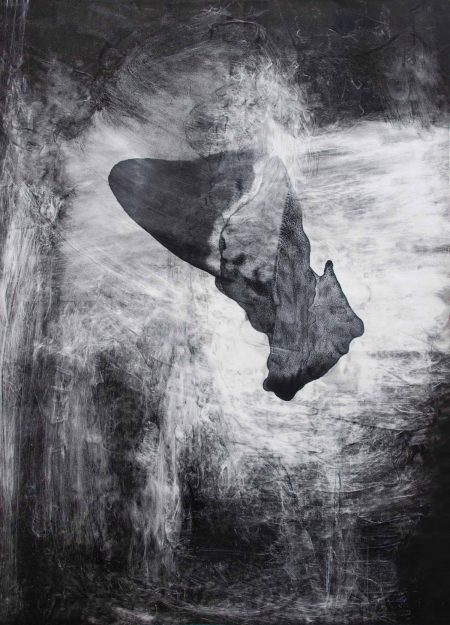
Patti Jordan’s “Can’t Take It With You (Memento Mori 010) from the Devolution series” (2021) takes advantage of the monotype’s ability to subtract as well as add lines and forms. The artist seems to have applied a layer of jet black ink to her plate and then worked at scraping it off, producing slender if jagged white lines beyond counting. It is like a scrubbing a dirty pot with brillo or a tumult of chalked graffiti on a blackened wall. Stepping back, there is something figurative about the white shape, a kind of bulky or cloaked stick figure with a staff, perhaps, but ghostly and immaterial. Superimposed over this central drawing—a part presumably added later—is a less readable shape, organic and fluid but not fully formed, like a bodily organ whose function is hard to detect. It is part x-ray of the body within and part something that floats free of the figure behind it. We see the body and what it contains—or perhaps what it cannot contain. It does not seem impossible to imagine that the work consists of two different fantasies about the body, neither particularly comforting, each defined by a different kind of mark-making.
Tony Holmquist’s “Silver Mesa System” (2017) is, at first look, simplicity itself. It consists of six loops, each fully populated with crowds of tiny lines with barely any space between them, that circles back on itself, like a run-over snake that had been swallowing itself. But as the Manifest’s show argues, I think successfully, we have to accord serious attention to that seemingly endless parade of tiny marks. In fact, no two are alike: each swells just a bit in its way, they overlap irregularly, some are darker than others, they are separated by irregular distances. What seems like an image that could have been machine-made turns out to be a celebration of what only the hand can produce. Like Sabella’s “Blends,” once the touch is brought into play, the impression of depth can be easily suggested. And while the overall impression may be of a static shape, the lines remind us of how things grow: trees have rings, skin has wrinkles. We soon see that actually, the hand has been everywhere here. Even the chine collé on which the image is printed has been hand-trimmed close to every curve, but not with mathematical precision.
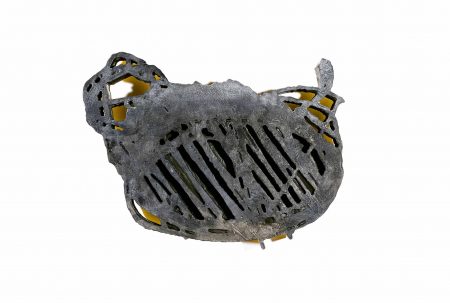
In a show that seems patient and perceptive about what the artist’s mark is and does, William Potter’s “Drawing Lessons—Dark Chunk” (2021) is an unusually adventurous choice of work. “Dark Chunk” is a wall-mounted, thick black plywood sculpture that monumentalizes the scribble, as firm and fixed in its form as other works played with the fluid. Though in some ways it is anything but hand-drawn—it is not easy to imagine the tool that can sculpt plywood with such planned irregularity–its casual origins are never far from view. It reminds us of how deliciously complex even our simplest of casual drawings can be, here enlarged by many measures and done in very substantial plywood some three or four inches deep. The form is roughly oval with a series of more or less parallel lines connecting the long sides. There are some extravagant arcs extending from the top. There are even signs of drips pulled by gravity at the bottom. The lines give the piece the feel of a grill and the dark color of this particular piece (others of Potter’s pieces are neon bright and multi-colored) make it look like something salvaged from a junkyard. But on close look, the surface of the piece has been formed and painted to preserve the presence of the hand: the flatness is continually embellished by cross-hatched networks of lines, and the excellent lighting in the gallery emphasizes both the deep shadows of the work as a whole and the tiny shadows that dapple its surface. It is hard not to wonder what a work like this might look like done much larger yet (in steel, perhaps?) so that scale could play a part in our encounter with an enlargement of a daydream.
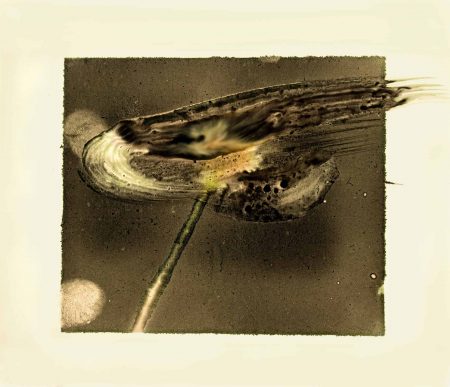
I take David Clark’s “Blown” (2021) as a sort of climactic work in this strong show. He starts with a photograph—a medium that is in many ways devoid of the presence of the mark—of a flower. We can tell the origin of the image because we can still see the stem. But he has, by means electronic or chemical, obliterated the flower itself, dissolving the surface of the photograph so as to make it susceptible to imposition of marks. Where there once were petals, there is now an irregular swoosh which transforms the pictorial information that once was a flower and carries it clear outside the frame of the image. A “blown” flower is merely one that has already bloomed. Here Clark adds the element of a fierce, deconstructing wind that is tearing the flower apart. The currents of pigment that disrupt the floral image could have been made by any number of implements, but Clark leaves behind—literally—a pair of fingerprints that serve to suggest that the decomposition and re-making of the image has been done by hand. We are back in some ways to finger-painting, the childhood way of making marks, the drama of turning formless mess into something like a picture. I love the way that this picture now is and isn’t a flower and that the image’s sober sepia, that we might associate with the sobriety of much earlier photography, has been stirred into action by the tangible wind of the artist’s hand. The touch has become a force of nature.
To photography’s stasis, Clark has added the liquidity of the swirl, which is, I assume, as irrevocable once made as was Isaak’s rendition of her subject’s hair. The artist’s mark dances between what is permanent and what was fleeting but now cannot be undone. (It would be interesting to imagine what a kinetic version of some of the ideas in the show might look like.) The mark can be the result of rational decision or it can celebrate the role of chance, guided or anarchic. I see the drips at the bottom of Clark’s “Dark Chunks” now turned into three dimensional plywood as a little of each. In “Blown,” the imposition of the mark has changed everything, turning the work from a photograph to something else, something engaged with time and form in a different way. Though fingerprints on a print are traditionally a sign of sloppy workmanship, here they seem a welcome announcement of the presence of human actions and decisions. This is indeed art that is built from the touch, whether labored or fleeting, and the touch endures.
–Jonathan Kamholtz